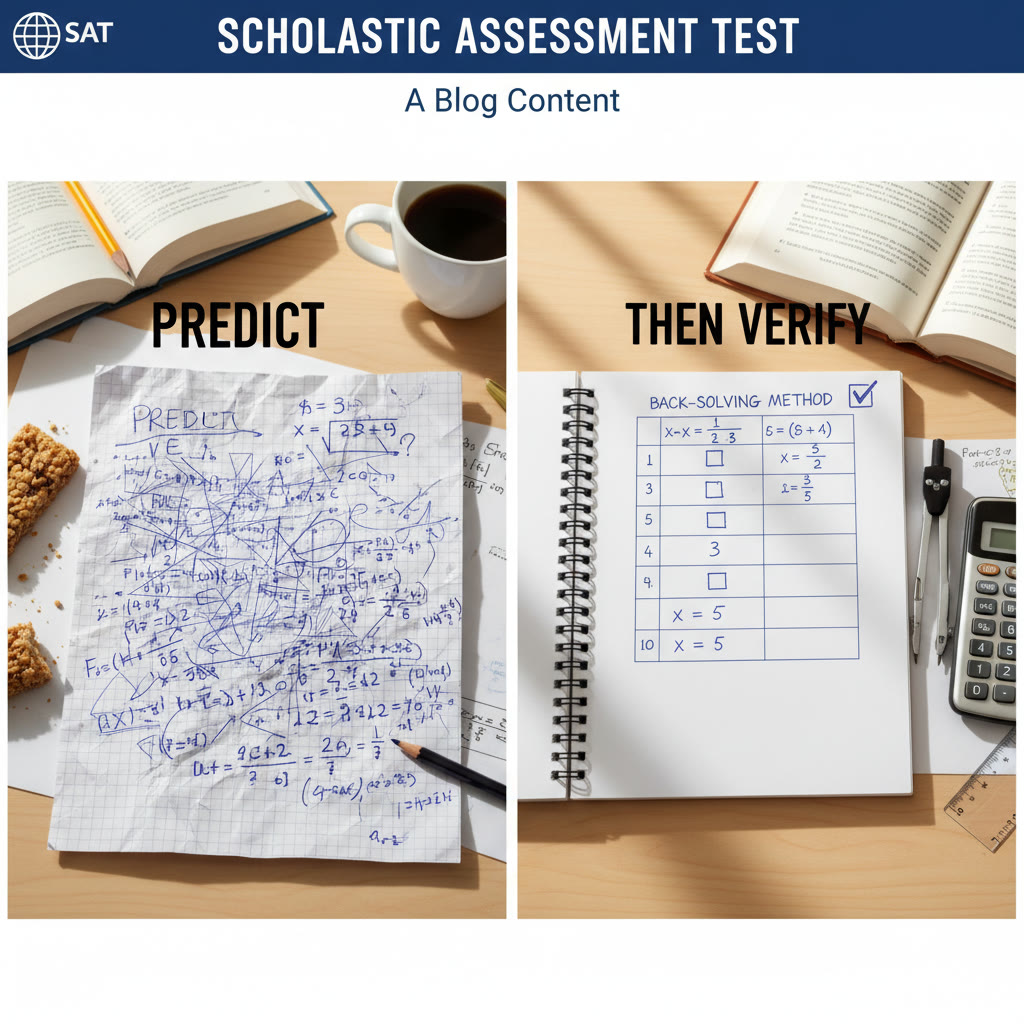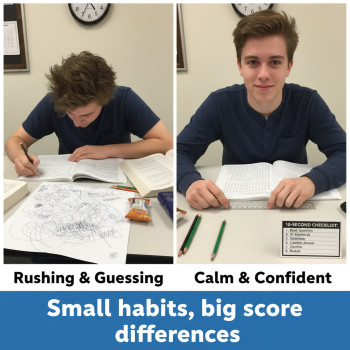Common Logical Traps in SAT Questions — How to Spot and Outsmart Them
Walk into any SAT section and you get more than content to master. You get a series of carefully designed puzzles meant to test not only knowledge but the way you think under pressure. Some of those puzzles are straightforward. Others hide little logical traps that can steal points even from well-prepared students.
This post is a friendly tour of the traps youll meet across Math, Reading, and Writing and Language. Youll see why these traps work, how to expose them, and how to answer with confidence. I include clear examples, comparisons, and a tidy table of quick fixes. And where it makes sense, I note how Sparkl’s personalized tutoring — with 1-on-1 guidance, tailored study plans, expert tutors, and AI-driven insights — can speed your progress.
Why the SAT uses logical traps
The test makers want to separate level of understanding. If every question rewarded guesswork, the exam would lose its diagnostic power. Logical traps do two things: they reward careful reading and penalize common, surface-level mistakes. In other words, they test deeper comprehension and reasoning under time constraints.
That sounds mean, but it also gives you leverage. Once you can recognize the traps, you can use them to your advantage: predict where a mistake might feel tempting and build habits that avoid those mistakes routinely.
General habits that defeat traps
- Predict before you peek. Read the question stem and try to form an answer in your head before scanning choices.
- Circle qualifiers and negative words. Words like only, most, least, except, and not change everything.
- Annotate and simplify. For Reading, underline the line reference. For Math, rewrite the equation or draw a small diagram if the figure is not to scale.
- Use backsolving and plugging in numbers for algebraic traps.
- Eliminate, even when you think you know the answer. Wrong choices are often attractive because they contain partial truths.
- Watch time on easier questions; don’t get trapped by a single stubborn problem.
Math traps: where the numbers mislead
Math on the SAT is not just computation. Many traps live in the language of the problem, in careless algebra, or in assumptions about diagrams and domains.
Trap: Misreading constraints and domain restrictions
Example: “For real values of x, solve sqrt(x-2) + 3 = 7.” A careless student might subtract 3 and square both sides, but they may forget the domain condition x-2 ≥ 0. That oversight can introduce extraneous solutions when you manipulate equations.
Quick fix: Before manipulating square roots, exponents, or fractions, list domain constraints. After solving, plug each solution into the original equation to confirm.
Trap: Not-to-scale figures
Diagrams can be expressive but not accurate. The test often labels a diagram as “not drawn to scale”. If you base a numeric conclusion on the picture rather than on given lengths or angles, you can be lured into a wrong answer that looks right.
Example: A triangle looks like a right triangle in the diagram, but no angle measure was given. Always rely on the written information, not the drawing.
Trap: Answer choices that cancel a misstep
Multiple-choice answers can hide algebraic errors. Suppose you manipulate an equation incorrectly but, by coincidence, arrive at one of the provided choices. The presence of that choice tempts you to stop early.
Quick fix: If a manipulation is messy, use backsolving. Pick an answer and check it in the original equation. This is often faster and safer.
Trap: Hidden meanings in words like consecutive or difference
Words that define relationships (consecutive integers, difference of squares, increasing, decreasing) create structure you must exploit. A common trap is treating ‘consecutive’ as ‘close’ or ‘nearly’ rather than a strict arithmetic relation.
Example: “The sum of five consecutive integers is 35. What is the middle integer?” Too many students try random numbers. Set the middle as n and write 5n = 35, n = 7 — quick, clean, and impossible to misinterpret.
Trap: Careless manipulation with fractions and ratios
Ratios are fertile ground for trap answers. The SAT loves to give you proportional setups where students cancel incorrectly or invert a ratio by mistake.
Quick fix: Convert ratios to fractions explicitly and, when possible, plug in simple numbers that preserve the ratio to test outcomes.
Trap: Extraneous roots and factoring pitfalls
When you square both sides or multiply by expressions that might be zero, you can create extraneous roots. Also, factoring errors happen when you assume factorability without checking discriminants or signs.
Quick fix: After algebraic transformations, always substitute solutions back into the original expression to confirm validity.
Reading traps: the sneaky language of passage questions
The Reading section tests comprehension, but its traps are mostly linguistic and strategic. The SAT writers know which words make test-takers wobble: absolute qualifiers, scope ambiguities, and paraphrase choices that preserve tone but change meaning.
Trap: Extreme answer choices and absolute words
Choices that use words like always, never, all, and none are often wrong because they leave no room for nuance. The scientific or historical passage on the SAT usually saturates complexity with exceptions.
Example: A passage says that a scientist found a trend in limited observations. An answer choice claiming the evidence proves the theory always holds is probably wrong.
Trap: Wrong emphasis and paraphrase mismatches
Questions ask for central idea or primary purpose. Wrong choices often rewrite a secondary detail or change the intended emphasis. Test-writers create distractors that are true statements but not the main point.
Quick fix: Ask yourself, If I had to give this passage a one-line headline, what would it be? Then choose the option that matches that headline.
Trap: Shifts in scope and pronoun references
Pronouns like it, they, or this can change reference mid-paragraph, creating confusion. A common trap is answering a question based on the wrong antecedent.
Quick fix: Trace pronouns backward to their nearest nouns and confirm that the choice you pick aligns with the correct reference.
Trap: Data and number interpretation
When passages include statistics, the trap is assuming causation from correlation, or misreading percentages versus absolute values. A study might report that 60 percent of a small sample experienced X; that does not automatically generalize.
Quick fix: Pay attention to sample size and exact wording: words like suggests, indicates, and implies are milder than proves.
Writing and Language traps: grammar that fools you
The Writing and Language section is grammar with a twist: it tests clarity, concision, and rhetorical logic as much as it tests punctuation and agreement.
Trap: Misleading parallelism and comparisons
Parallel structure errors are classic. Trap choices often add a word or rephrase so that parallelism breaks subtly — for example, mixing verbs with noun phrases.
Example: Choose the sentence that completes the list: “She likes hiking, swimming, and to ride bikes.” The trap is that the last item is not parallel. Change it to “riding bikes” to match.
Trap: Dangling modifiers and unclear referents
A dangling modifier makes it unclear who is doing what. Test-makers give answer choices that sound polished but misplace the modifier.
Quick fix: Identify the subject being modified and ensure the modifier sits immediately next to it.
Trap: Comma splices, run-ons, and punctuation tricks
Some punctuation traps hinge on distinguishing independent clauses, using semicolons correctly, or recognizing when a sentence needs a dash or parenthetical.
Quick fix: Replace complex punctuation by forcing you to speak the sentence aloud. If you naturally pause for emphasis, a dash or semicolon might be right; if you can say both clauses as separate sentences, a period might be the best edit.
Worked example: A tricky multi-part SAT-style question
Let’s dissect a representative problem that blends math and language traps.
Problem: A local cafe doubles the price of a pastry every 6 months. If the price was $2.00 at the start of the year, which of the following is closest to the price after 18 months?
- A 6.00
- B 8.00
- C 12.00
- D 16.00
Trap: Doubling every 6 months means three doublings in 18 months, not multiplying by 1.5 or adding a linear increase. Everyone who reads too quickly may calculate 2 + 3*2 = 8 and pick B.
Correct approach: Start with $2.00. After one doubling: 4; after two: 8; after three: 16. So D is correct. The trap exploits linear thinking instead of exponential growth.
Fast strategies to avoid traps on test day
- Predict the answer before opening choices. This reduces influence from cleverly worded distractors.
- Circle negative words and qualifiers. Not, least, and except require a different strategy than an affirmative stem.
- For algebra, backsolve when algebra seems messy. Plugging in answer choices is often faster and safer.
- When stuck on a Reading question, mark the lines and re-read the immediate sentences around the reference. Many wrong answers are supported by text that lies elsewhere in the passage.
- Check your units and scale on Math; a wrong unit can make an answer look plausible.
- Don’t overcomplicate: the SAT often rewards clear, minimal steps rather than long, sophisticated approaches that invite small errors.
Quick reference table: traps and quick fixes
| Trap | Where it appears | Quick fix |
|---|---|---|
| Absolute language | Reading & Writing | Be skeptical of always/never; prefer choices that allow nuance |
| Not-to-scale diagram | Math | Rely on given measures, not picture |
| Extraneous roots | Math | List domain constraints and check solutions |
| Misplaced modifier | Writing | Identify the subject and place modifier next to it |
| Pronoun ambiguity | Reading & Writing | Trace the pronoun to the exact antecedent |
| Ratio inversion mistakes | Math | Rewrite ratios as fractions or plug in numbers |
Practice methods that build trap immunity
Recognizing traps is a skill built with deliberate practice. It comes down to repeated exposure, reflection, and targeted correction.
- Do timed sets, but review untimed. When you miss a question, analyze the logical trap rather than just the right answer.
- Keep an error log. Write down the type of trap that fooled you and the clean rule that would have prevented it.
- Simulate test pressure occasionally. Time pressure increases the chance youll fall for small wording traps, so practice performing under similar conditions.
- Compare strategies. For math, try both algebraic manipulation and backsolving; notice which traps each method exposes.
How targeted tutoring like Sparkl can help
Some traps are personal: you might be more likely to misread negative qualifiers, or to make sloppy cancellations in algebra. That’s where focused, personalized help makes a big difference.
Sparkl’s personalized tutoring offers 1-on-1 guidance and tailored study plans so you can attack the traps that specifically cost you points. Expert tutors can model the mental checklist you should run through on each question. AI-driven insights help spot patterns in your mistakes so every session moves you forward efficiently rather than repeating the same errors.
Think of tutoring as a rehearsal coach who points out when youve fallen into a recurring trap and gives you concrete drills to fix the habit. With short, consistent input, many students find they lose the most common traps entirely and gain time and confidence on test day.
Putting it into practice: a 4-week mini-plan
If you have a month to sharpen up, here is a focused plan to reduce trap-related errors quickly.
- Week 1: Diagnostics. Take a practice test and build an error log that categorizes each missed question by trap type.
- Week 2: Targeted drills. Spend three sessions on your top two trap types. Use short timed sections and then untimed review.
- Week 3: Strategy layering. Learn and apply strategies like backsolving, plugging in numbers, and annotating passages. Time yourself on sections but stop for reflection after each missed question.
- Week 4: Mock tests and review. Take two full-length practice tests spaced by at least two days. Use the intervening days for targeted review of your new mistakes.
Final thoughts: the psychology of traps
Understand that traps succeed because they exploit natural, often useful cognitive shortcuts. Hasty pattern recognition, reliance on visual cues, or trusting an answer that sounds plausible are all shortcuts that generally help but sometimes mislead.
The antidote is not to distrust your instincts entirely, but to pair them with a few consistent habits: pause to predict, note qualifiers, check domains, and verify solutions in original forms. Over time these habits become automatic and the traps stop being traps.
Image ideas


Wrap-up
Logical traps on the SAT are survivable. Theyre predictable, and once you learn to recognize the signs — absolute language, hidden domain issues, ambiguous pronouns, and diagram deception — you can neutralize them on the fly. Use the quick fixes above, keep an error log, and build a practice rhythm that focuses on your personal weak spots.
If you want accelerated progress, consider supplementing practice with focused tutoring. Sparkl’s personalized tutoring, with 1-on-1 guidance, tailored study plans, expert tutors, and AI-driven insights, helps many students isolate and remove the most damaging traps from their test performance.
Becoming trap-proof is a mix of careful reading, smart strategies, and practice that targets your specific missteps. Make those habits second nature, and the SAT stops feeling like a minefield and starts feeling like a predictable game you can win.












No Comments
Leave a comment Cancel